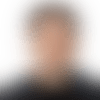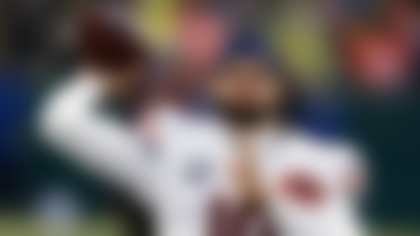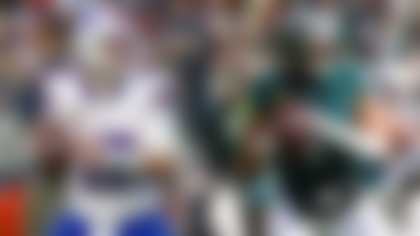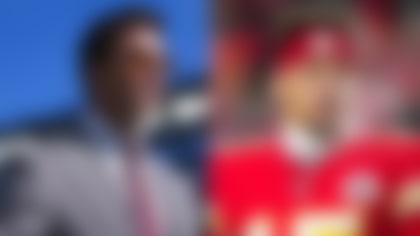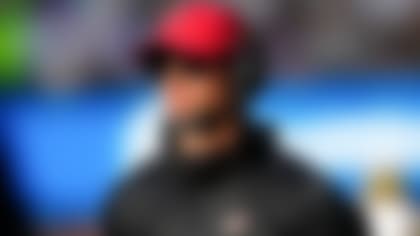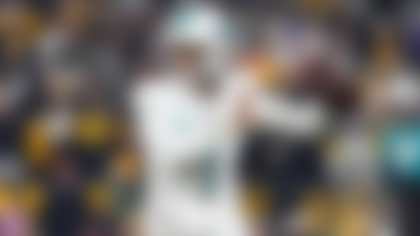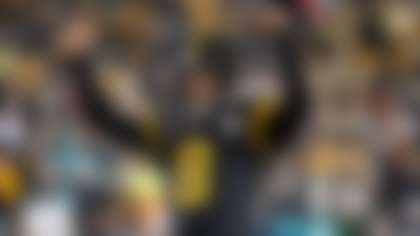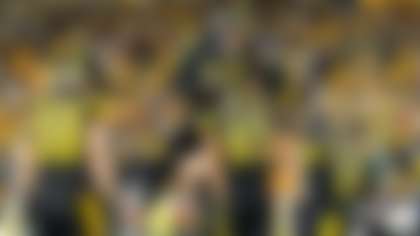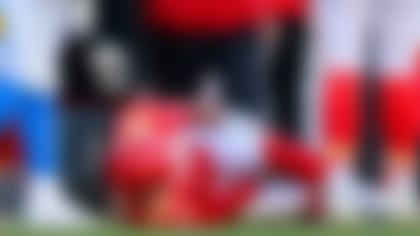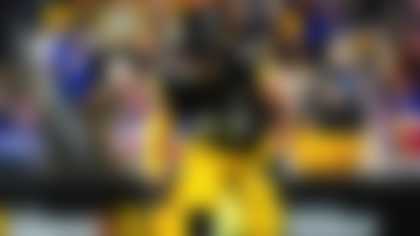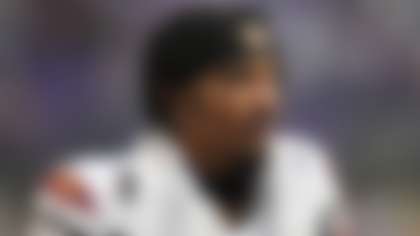The Arizona Cardinals could have the most loaded roster in the NFL. They also have only one offensive tackle that has ever played an NFL game.
That roster hole, which showed up in our recent projected starters series, is a good reminder that even the best teams have question marks. In a salary-cap league with every rule designed to promote
mediocrity
parity, there are no perfect depth charts. Every team has a few spots where they are hoping to simply survive.
Here's a quick look at one area that each NFC team has to worry about heading into the season:
NFC East
Dallas Cowboys: The offense is absolutely loaded but Dallas' pass rush is a huge question mark, especially early in the season. Demarcus Lawrence and Randy Gregory face suspension for the first four games of the year, and Gregory has to prove he's a capable pro. Fourth-round pick Charles Tapper could wind up starting early in the season, with Tyrone Crawford moving over from defensive tackle. Even when Gregory and Lawrence get back, the Cowboys might have to generate pressure with blitzes too often to keep the heat off their shaky secondary.
Philadelphia Eagles:Nelson Agholor was the least productive starting receiver per snap in football last season. And the team never found any real competition for him with Josh Huff and Rueben Randle next in line. This is a roster that has many options at many positions: quarterback, offensive line and tight end included. Sam Bradford has not shown the ability to elevate his teammates and that will be necessary with this receiver crew.
Washington Redskins: It's surprising that a team built by general manager Scot McCloughan has so many questions up front. Defensive end Chris Baker is the only surefire starter on the defensive line. They don't really have a natural nose tackle except for their fifth-round pick Matthew Ioannidis, and expecting him to play big snaps is expecting too much. Stephen Paea was serviceable last year and the team also brought in Kendall Reyes from San Diego. That's a lot of players without any difference makers.
McCloughan has done a great job improving the Redskins' roster, starting on offense. The defense has more boom or bust options and has the look of a group that will be in a lot of shootouts this year.
New York Giants: Was the Giants offensive line the problem or was it the underwhelming running backs last year? Shane Vereen checks the box as a quality third-down back, but this team continues to give Rashad Jennings too many chances as a lead back. Fifth-round pick Paul Perkins will have a chance to make a quick impact, and the Giants don't have an offensive line that can carry the day after failing to upgrade its right side in the offseason.
NFC North
Green Bay Packers: When inside linebacker is your roster's biggest weakness in the year 2016, you are doing something right. General manager Ted Thompson deserves credit for not leaving any spot on the roster too barren, but the team's lack of natural pass rushers means that Clay Matthews will be back on the outside far more often in 2016. (As he should be.)
That leaves rookie linebacker Blake Martinez with the chance to earn starter-worthy snaps over Sam Barrington on passing downs. Look for a three-man rotation between Martinez, Barrington, and last year's fourth-rounder Jake Ryan. Martinez has the best passing-down skill set of the trio.
Minnesota Vikings: The Vikings entered the offseason insistent they would address the offensive line, and that's exactly what they did. Yet it remains a concern. Matt Kalil is seemingly on his last chance to prove he is a starting-level left tackle, much less a top-10 talent. The Bengals were ready to move on from right tackle Andre Smith for a reason. Phil Loadholt is coming off Achilles tendon surgery.
The Vikings have depth at tackle with T.J. Clemmings also in the mix, but do they have two average NFL starters? If Teddy Bridgewater doesn't get protection, that will trickle down to impact another roster concern at wide receiver.
Detroit Lions: This is a division full of big receivers to deal with. That makes cornerback play even more crucial, and Detroit is weak there with youngsters Nevin Lawson and Quandre Diggs next in line after underrated starter Darius Slay. The Lions used to rely on a superior defensive line to cover up for the secondary, but that blueprint no longer works because defensive end also looks thin after Ezekiel Ansah.
The profile of this team has changed so dramatically since the 2014 season when they won 11 games. The Lions will need to rely a lot more on their offense despite the retirement on Calvin Johnson. In Jim Bob Cooter we trust.
Chicago Bears: Taking over for Adam Gase will be difficult enough for offensive coordinator Dowell Loggains. Doing it with Charles Leno and Bobby Massie as the team's starting tackles will make it especially difficult.
The Bears played feisty football under John Fox last season despite their lack of talent, and the front seven looks more fun than coloring books in a Chicago warehouse. Still, the team's issues are typical of a league-wide trend. The hardest parts to fix on most teams come at offensive tackle and in the secondary.
NFC South
Carolina Panthers: General manager Dave Gettleman and coach Ron Rivera have turned secondary extreme makeovers into an art form. Until this season, the Panthers didn't have a single player taken higher than the fourth round in the defensive backfield. No. 62 overall pick James Bradberry and No. 77 overall pick Daryl Worley will change that, but the Panthers could be asking too much of two unheralded rookies behind Bene' Benwikere and Robert McClain.
The Panthers' system relies on front-seven magic, scheme and great coaching to cover up for lack of secondary talent. That system will be tested to the limit this year.
New Orleans Saints: A defense that finishes dead last in successive years naturally has more than one option to choose from when looking for flaws. We'll start at linebacker, where James Laurinaitis and Dannell Ellerbe are slated to potentially start. There is a noted lack of speed throughout the Saints defense and it could show up at the second level, especially on passing downs.
Atlanta Falcons: One weapon is not enough. While we could pick Atlanta's lack of a pass rush as the glaring problem for the 17th straight season, the team's receiving weapons for Matt Ryan are just as concerning. Mohamed Sanu is a quality role player who is being paid like a star but could struggle to handle the No. 2 receiver role. Justin Hardy as the team's third option and Jacob Tamme or rookie Austin Hooper as starting tight end options similarly don't inspire belief.
Tampa Bay Buccaneers: At least the Bucs put in the effort to address their defensive end hole. If rookie Noah Spence starts, last season's top Bucs sack artist Jacquies Smith could be forced to the bench behind Spence and free agent pickup Robert Ayers.
Mike Smith inherits an uneven yet intriguing defensive roster that includes foundation pieces like Gerald McCoy and Lavonte David. It still feels like a work in progress that is looking for permanent solutions at defensive end and safety. Perhaps Spence can be a start.
NFC West
Arizona Cardinals: Bruce Arians' team was largely the inspiration for this column. They have the most projected wins in football by Football Outsiders, a campaign platform we can support. Yet the thin tackle group listed above isn't even their biggest roster concern.
Justin Bethel, who excelled as a No. 4 cornerback and special teamer, now stands second on the team's depth chart. He recently underwent foot surgery. Patrick Peterson is coming off ankle surgery, while Tyrann Mathieu is recovering from a torn ACL. Third-round pick Brandon Williams was seen as a project at cornerback after splitting time as a running back in college. Even though the Cardinals play a ton of safeties and Mathieu essentially plays cornerback, the Cardinals have a shocking lack of NFL-caliber cornerbacks on the roster. Don't be surprised if they add a veteran or two.
Seattle Seahawks: The Seahawks have been one of the three best NFC teams in each of the last four years, an incredible feat in such a tumultuous league. You could argue they've been even better than that:
To obtain another flag that flies in this temporal world, the Seahawks want to improve Russell Wilson's pass protection. They are going about it in a difficult way. They will start five offensive linemen either new to the team or changing positions. Garry Gilliam was not particularly effective at right tackle last year. Now he's moving to left tackle. Justin Britt is moving to center. The rest of the line is comprised of undrafted players, journeymen and 2016 draft picks like first-rounder Germain Ifedi, who comes with plenty of questions. The team is asking a lot of offensive line coach Tom Cable. They will ask even more of Wilson to overcome the franchise's annual bruise to an otherwise ripe roster.
San Francisco 49ers: At least the Seahawks have nothing to be worried about at quarterback. The 49ers, on the other hand, will need to scrape out every ounce of Chip Kelly's genius to make Blaine Gabbert or Colin Kaepernick a top-level starter. Reports in San Francisco suggest that the 49ers front office want Gabbert to win the job in order to punish Kaepernick for a trade request.
That healthy notion aside, we could pick on wide receiver or tight end as shaky positions for the 49ers. But it all starts behind center. If Kelly can take advantage of Gabbert and Kaepernick's athleticism, a quietly strong defensive front seven could keep this team competitive.
Los Angeles Rams: There are plenty of sunny spots in Los Angeles for Rams fans to cling to. But one position group that needed a remodel was boxed up in St. Louis, and brought unchanged to the west coast. Tavon Austin is a nice player, but he's not a No. 1 receiver. Kenny Britt and Brian Quick are next in line, while Lance Kendricks is the team's new/old starting tight end. The Rams finally have a quarterback, but they don't have enough weapons for Jared Goff to target.
